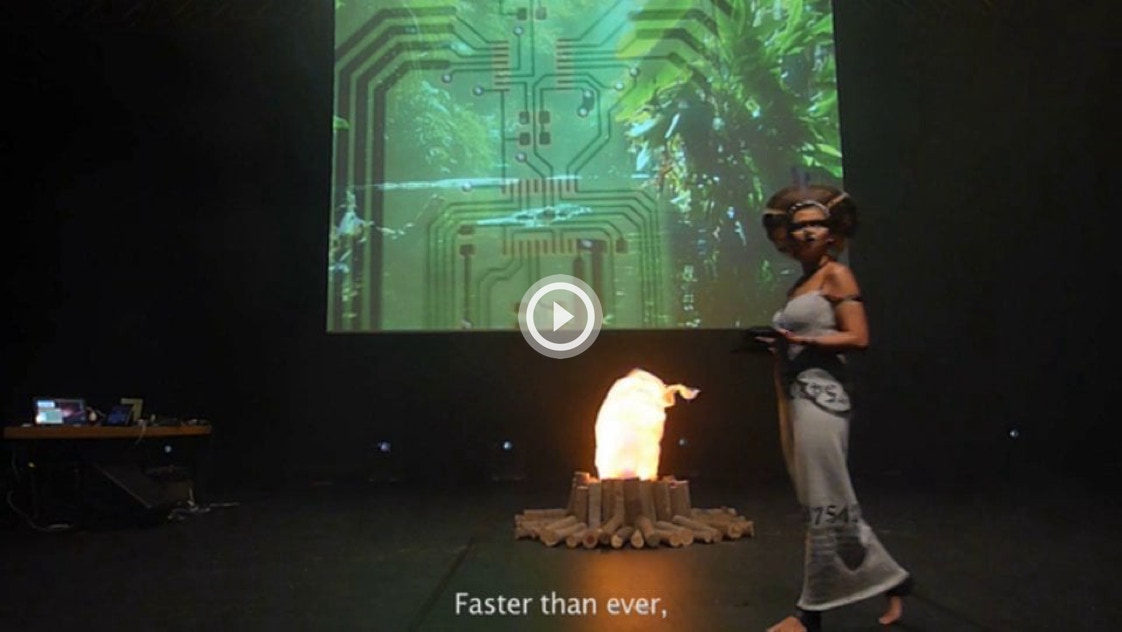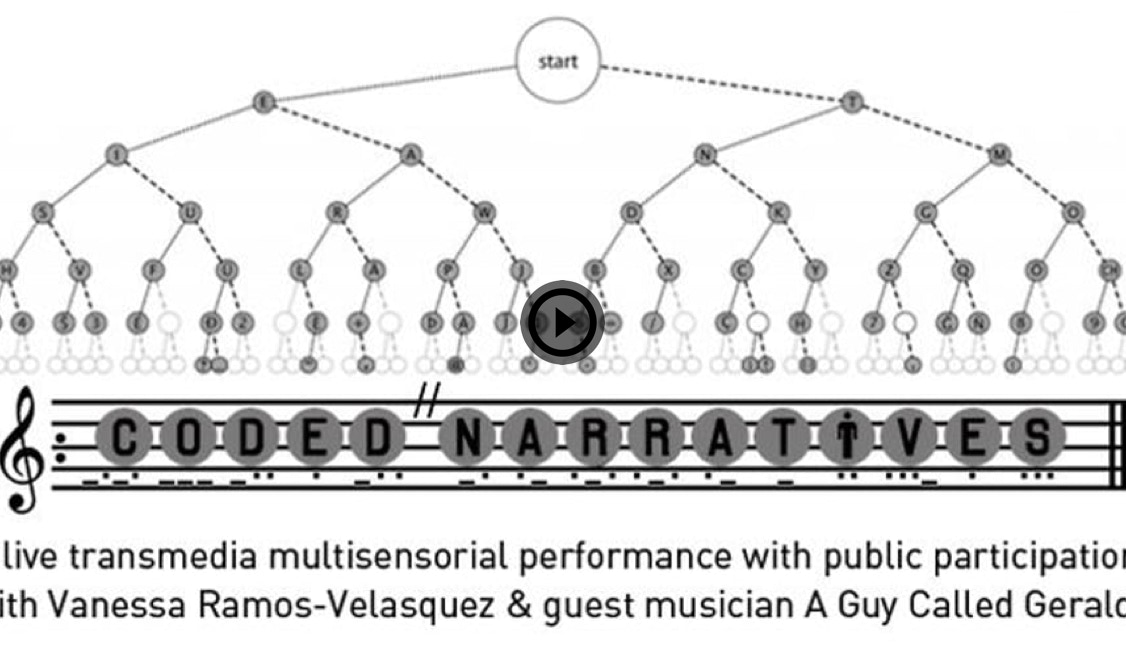CODED NARRATIVES (2013)
An interactive transmedia live performance with guest musician A Guy Called Gerald (UK)
Duration: 1 hour
EN
Coded Narratives is a retro-futuristic, campfire type of experience for the audience as active participants, articulated by the proto-programming language of Morse Code, declared dead in 1999. Coded Narratives is a story created intrinsically linked to its corresponding sound art, generated live via text input from the audience using an emerging technological object of digital media and communication—the tablet—as narrative tool and conduit of art. Other programming languages interact with Morse in the articulation of the tactile-audio-visual environment, resulting in a large chat-room, where the audience pours letters and meaning into the tablet as communal device and stirs the narrative in the cauldron of collective experience formed from individual input.
Vanessa Ramos-Velasquez is the artistic agent who formulates this socially interactive environment where the audience is invited as users of a system to generate the event that the audience/users experience and critique as it unfolds. The tablet is passed from person to person for the submission of text lines that are transcoded into Morse code binary tone immediately feeding into the sound apparatus of the musician, A Guy Called Gerald, who uses the tone as a layer of music composition.
For transmediale.13 and CTM the theme of Coded Narratives will be "Demotion" (being displaced) as standing for the process of degradation from a superior or relevant position to a diminished role like the Pluto, Morse Code or the disappearance of the single privileged source in the abundance of content and voices that is networked user culture. The audience is asked: How did you feel? What did you do when you were demoted? What will you do if you are ever displaced?
At transmediale.13/CTM. Main auditorium, Haus der Kulturen der Welt (HKW), Berlin.
DE
Coded Narratives ist ein retrofuturistisches Lagerfeuer-Erlebnis für ein aktiv beteiligtes Publikum. Es basiert auf der Proto-Programmiersprache der Morse-Zeichen, die man 1999 für tot erklärt hat. Die damit erzählte Geschichte wird mit Sound Art verknüpft, das Publikum generiert den Klang über Texteingaben selbst und nutzt ein aufstrebendes technisches Objekt der digitalen Kommunikation als narratives Tool und künstlerisches Medium: das Tablet. In dieser taktil-audiovisuellen Umgebung interagieren auch andere Programmiersprachen mit den Morsezeichen. Ergebnis ist ein großer Chatraum, in dem das Publikum Buchstaben und Inhalte in das als verbindendes Gerät fungierende Tablet eingibt. So entsteht die Geschichte als in der Gruppe erlebbares Potpourri individueller Eingaben.
Vanessa Ramos-Velasquez ist die künstlerische Akteurin, die diese interaktive soziale Umgebung gestaltet. Das Publikum ist eingeladen, mit dem System ein Ereignis zu generieren, das es im Entstehungsprozess selbst erlebt und kritisiert. Das Tablet wandert von Person zu Person. Die eingegebenen Sätze werden in Morsezeichen codiert und direkt in den Sound-Apparat des Musikers A Guy Called Gerald eingespeist, der angelehnt an den so entstehenden Ton Musik komponiert.
Anlässlich der transmediale und des CTM-Festivals greift das Projekt Coded Narratives das Thema „Degradierung“ (verdrängt werden) auf, also die Herabstufung von einer überlegenen Position in eine niedrigere, wie im Fall von Pluto oder von Morse-Zeichen geschehen, oder im Fall einzelner besonderer Quellen in dem Überfluss an Inhalten und Stimmen, der die vernetzte User-Kultur ausmacht. Das Publikum wird sich folgende Fragen stellen: Wie hat sich das angefühlt? Was haben Sie getan, als sie degradiert wurden? Was werden Sie tun, falls Sie eines Tages verdrängt werden?
PT
CODED NARRATIVES é uma experiência retrô-futurista remetente ao círculo em torno da fogueira, onde o público é convidado como participante ativo. O trabalho é articulado pela proto-línguagem de programação, código Morse, declarado morto em 1999. CODED NARRATIVES é uma fábula intrinsecamente ligada à sua arte sonora, pois é gerada ao vivo via input de texto dos membros da platéia, usando um objeto tecnológico emergente do meio digital, o “tablet.” Esta é ferramenta narrativa e condutora da arte, resultando em uma grande sala de "chat" onde o público inserindo frases no tablet que circula pelo público, conduz a narrativa na experiência coletiva formada a partir de contribuições individuais.
Vanessa Ramos-Velasquez é a agente que cria este ambiente social interativo, onde o público (“usuários”) é convidado a gerar o evento que ele próprio então experimenta e crítica durante o desdobramento. O tablet é passado de mão em mão, para o envio de um texto curto que é então transcodificado em tom de código binário Morse. Esse tom é imediatamente enviado ao aparelho de som do músico, A Guy Called Gerald, que utiliza essa entrada como uma camada na sua composição sonora ao vivo.
CODED NARRATIVES lida com o conceito de rebaixamento (deslocacão) como processo de degradação de uma posição superior ou relevante para um papel menor, como foi sofrido pelo planeta Plutão e o Código Morse. Na cultura em rede em geral o rebaixamento refere-se ao desaparecimento da única fonte de informação privilegiada dentre a abundância de conteúdo e de vozes nas plataformas online. Portanto a performance dialoga com o tema central de ambos festivais transmediale.13 e CTM.13. O público é perguntado: Como você encara o rebaixamento? O que fará se for deslocado?
Nesta performance de caráter ritualista, a artista brasileira desenvolve uma personagem remetente ao imaginário cultural da Pindorama, o Brasil pré-Cabraliano onde culturas tecnológicas com outras ferramentas já existiam. Uma ponte então é traçada entre tecnologias ancestrais e novas na construção de um imaginário cultural na era digital.

Upon entering the venue, the ambience setting is a technological jungle (on slide projection). Crickets sing. But it's a sampled sound of crickets. My persona is a syncretic figure composed of artifacts collected along the way... Indigenous headdress whose central feathers according to indigenous culture represent the antennas of communication; a white dress with silkscreened black numbers – bought in China; black painted mask – as much a warrior indigenous mask as a replicant in Bladerunner; Zen-like beads found in a forest; arm bands like tree nodes. My introduction before the invitation to participate sets up a sci-fi type of atmosphere, bladerunneresque with soliloquy inverted (TIME TO LIVE!) and adapted, slightly remixed, cross-cultured into the temporal mash-up for us to live our sci-fi in the very present... and reality is indeed stranger than fiction, but in fact we are already living the projections of our imagined science fictions. The future is now and a partial verdict as transpired in the text feed during the performance is copied below this text. However frail the initial connection to a theme may have been, the narrative style disintegrated into code, passing through memes and spamming. I'm not that surprised, because we can see this same behavior throughout a lot of social network platforms. But this gives me reason to continue my inquiry into digital culture. So here are some further considerations.

Your History is Our Poetry
Your Text into Morse Code=Binary Tone into Music.
Concept video and technical operation for the making of Coded Narratives.

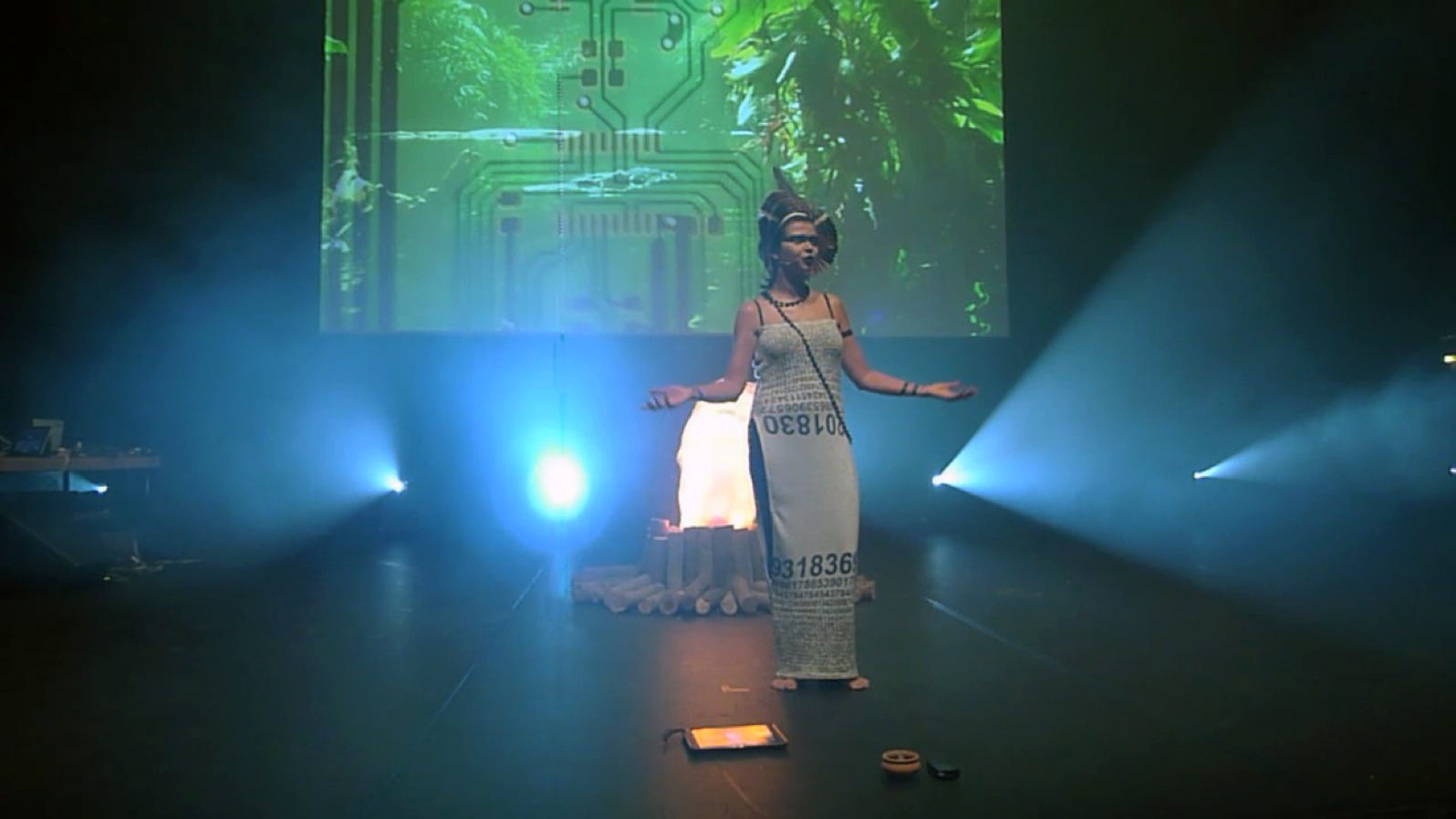
photo: Andreas Lang
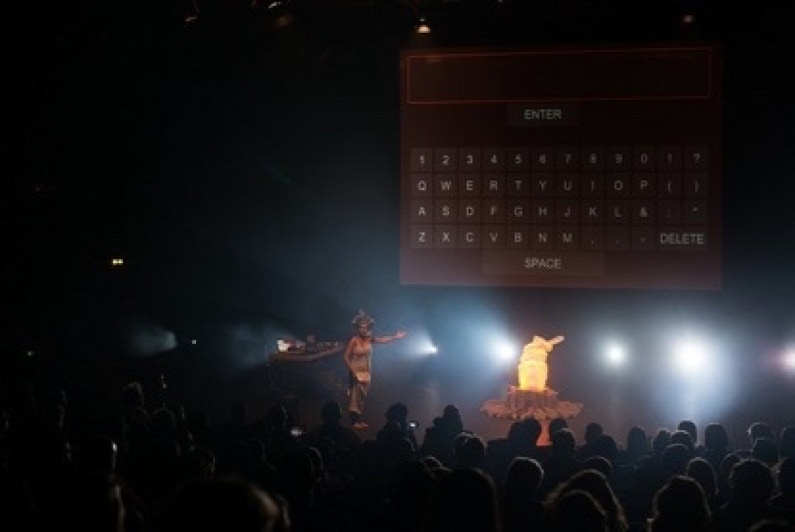
photo: transmediale
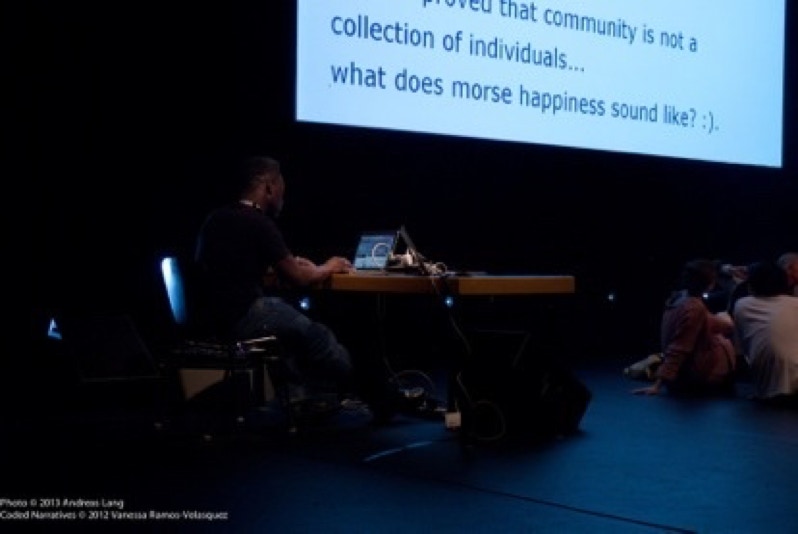
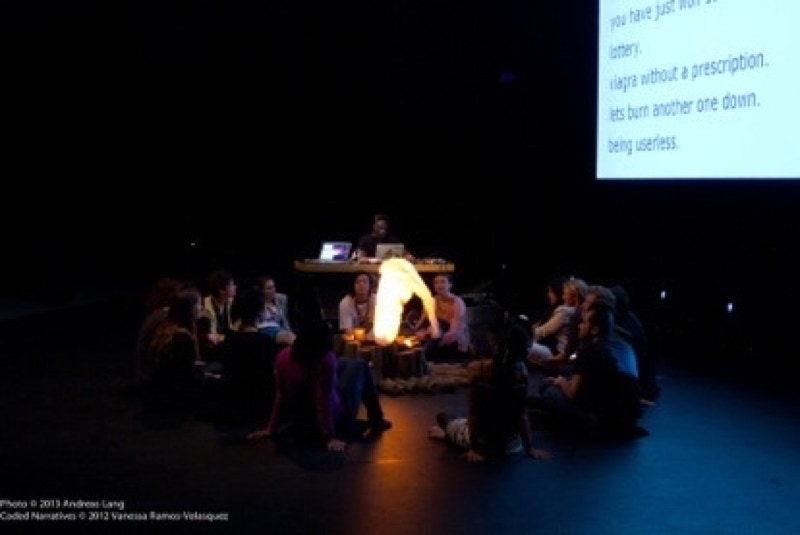
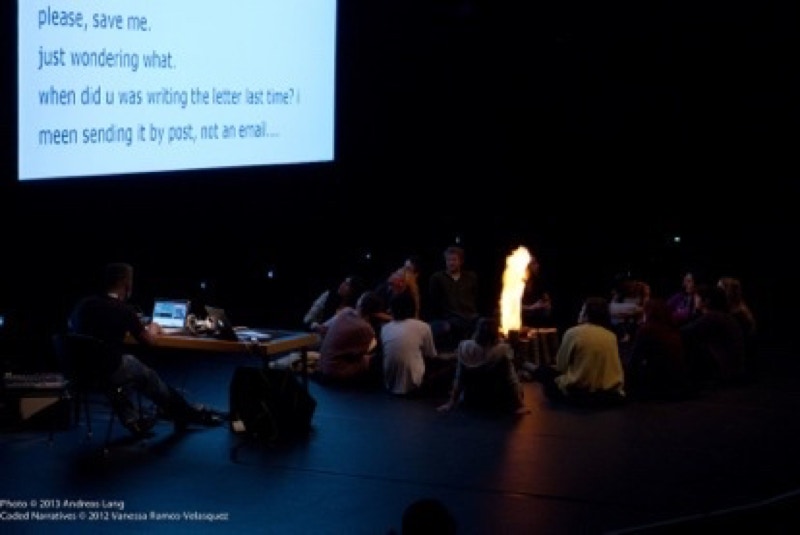
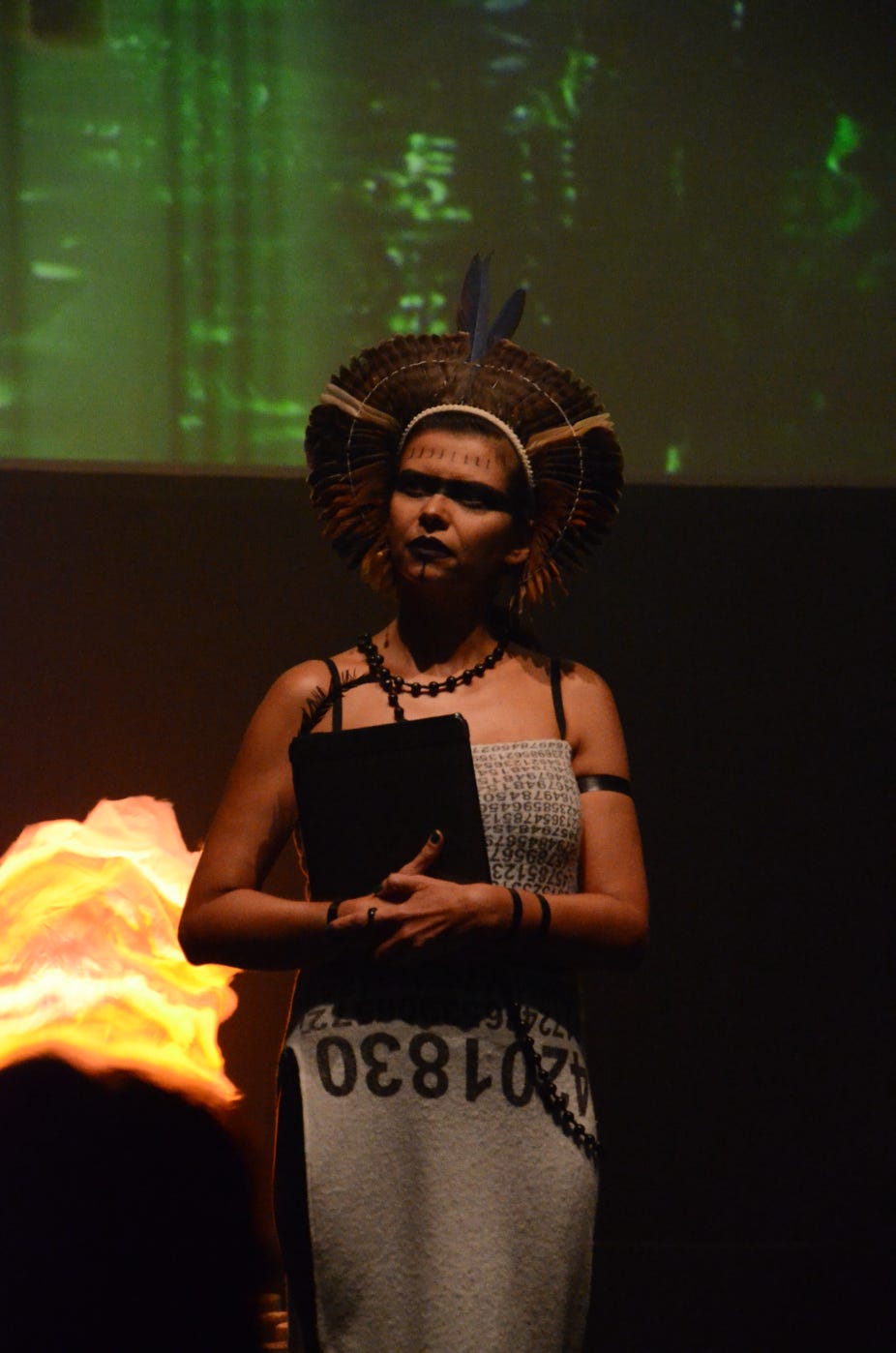
photo: Felipe Tofani
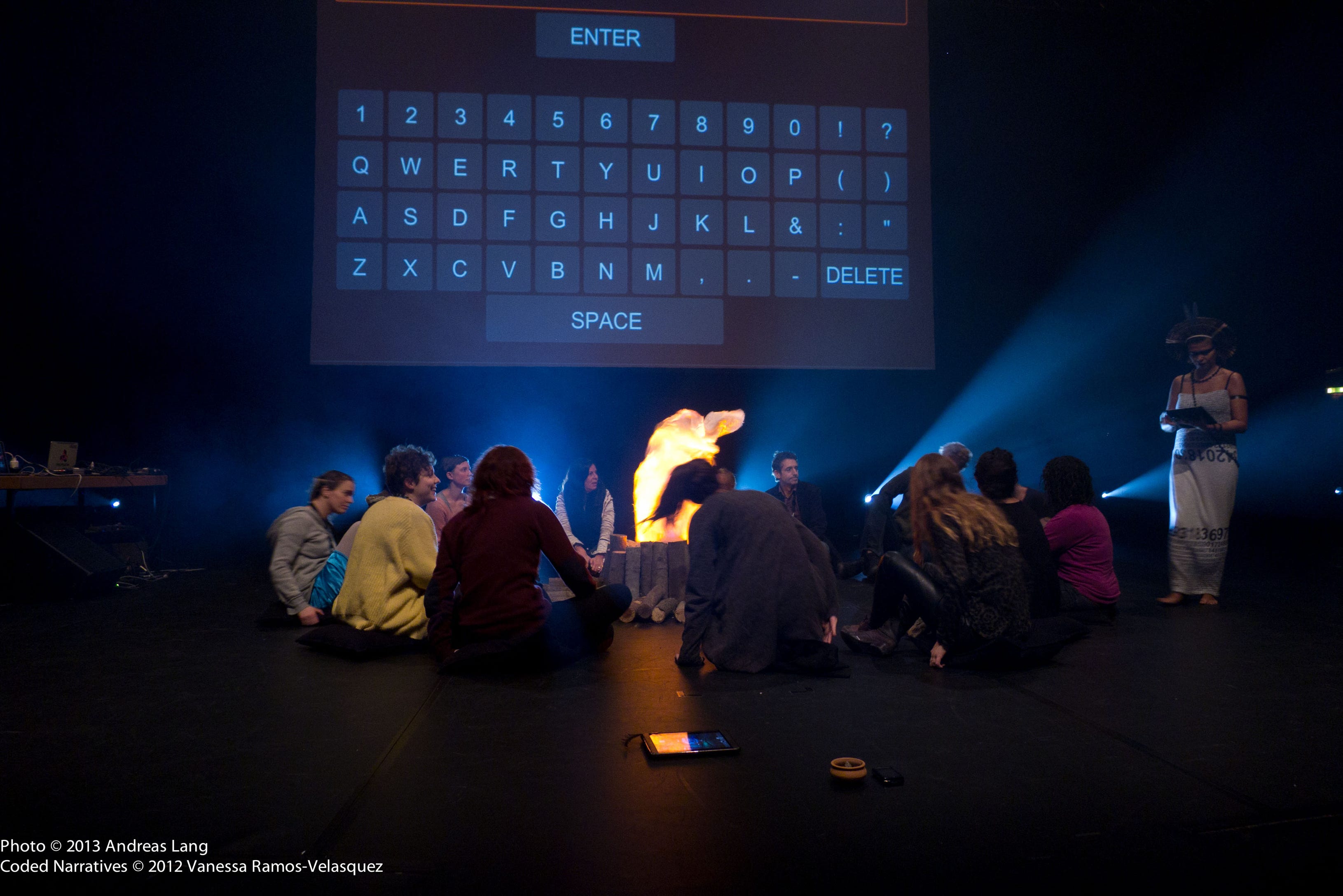
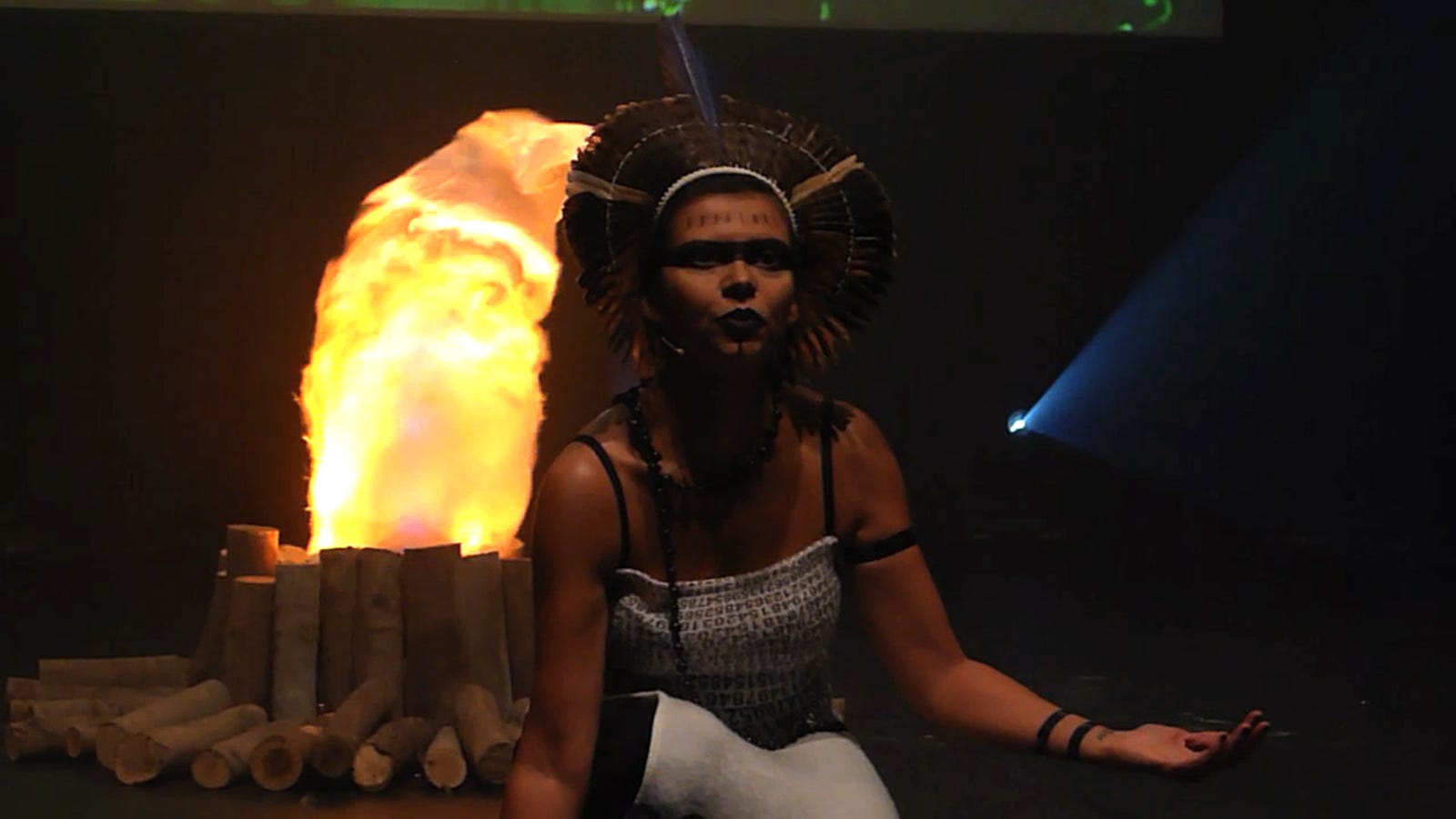
photo: Andreas Lang
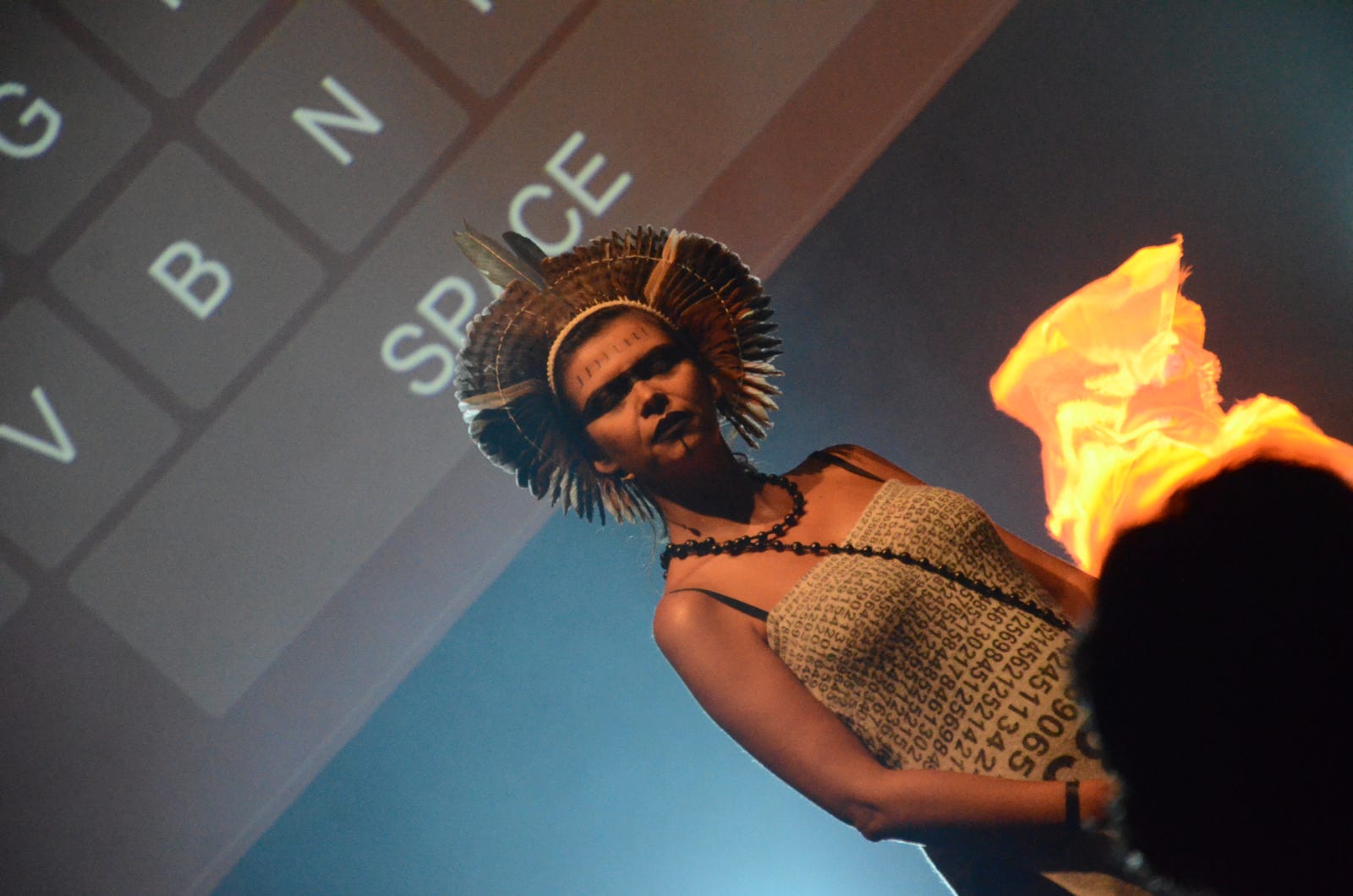
photo: Anna Schiwitza
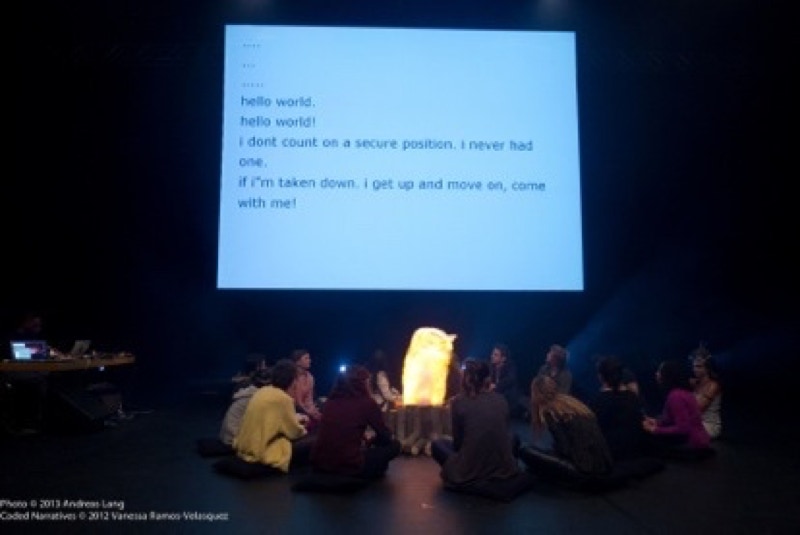
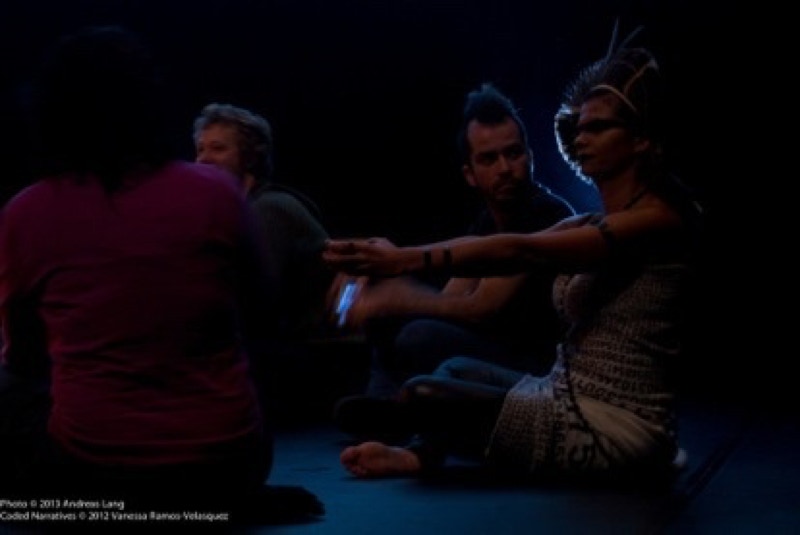
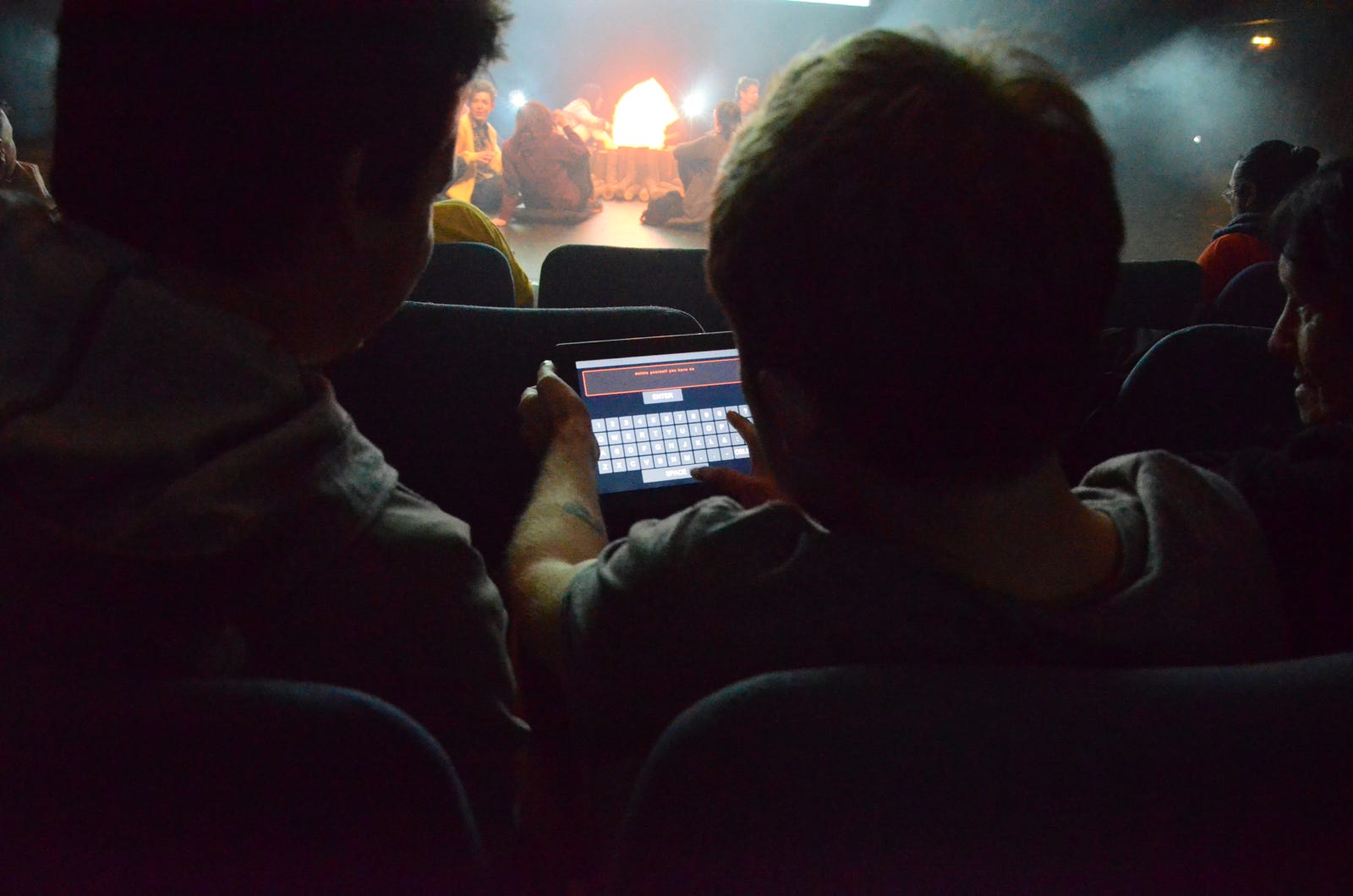
photo: Anna Schiwitza
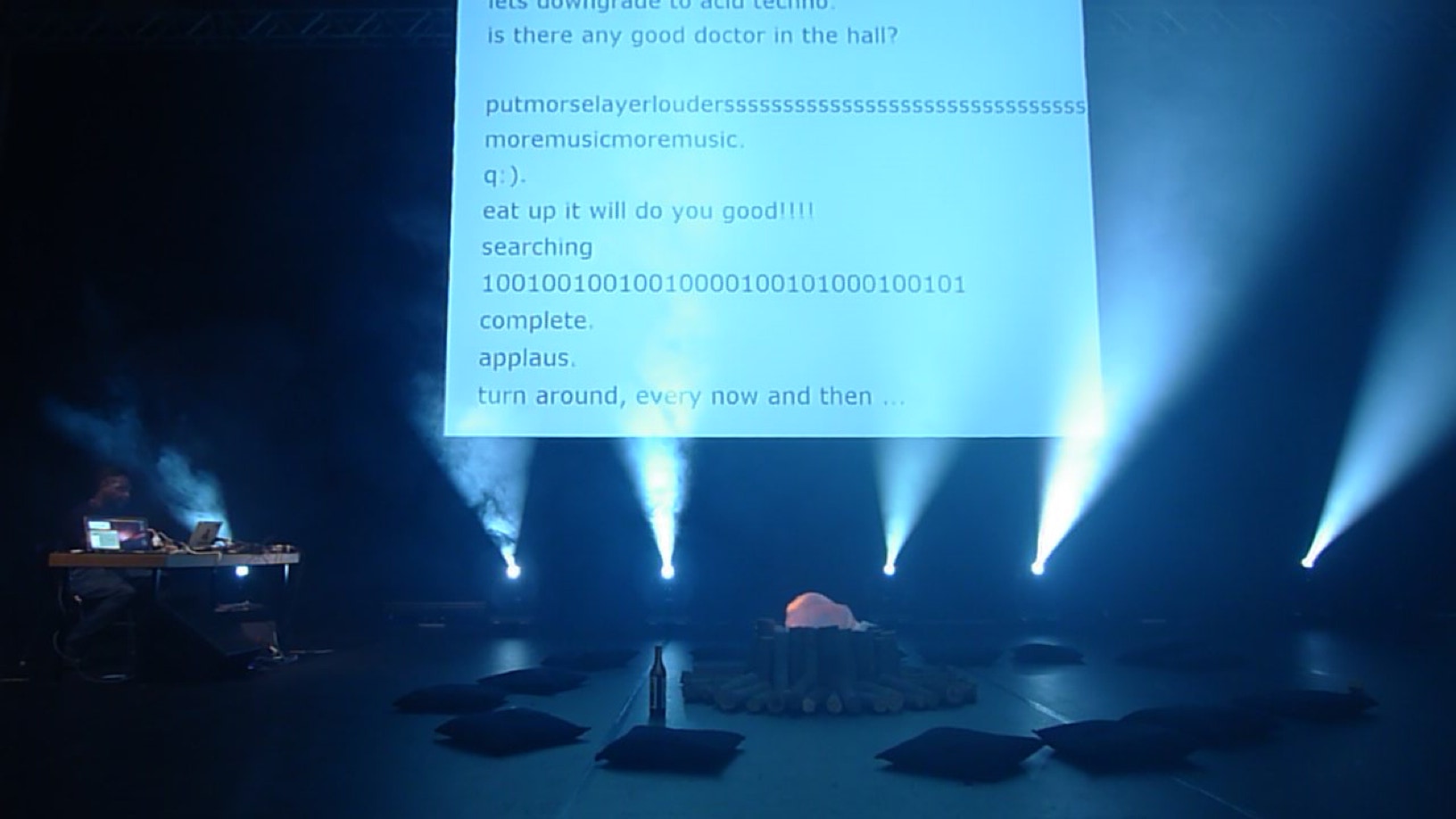
photo: Andreas Lang
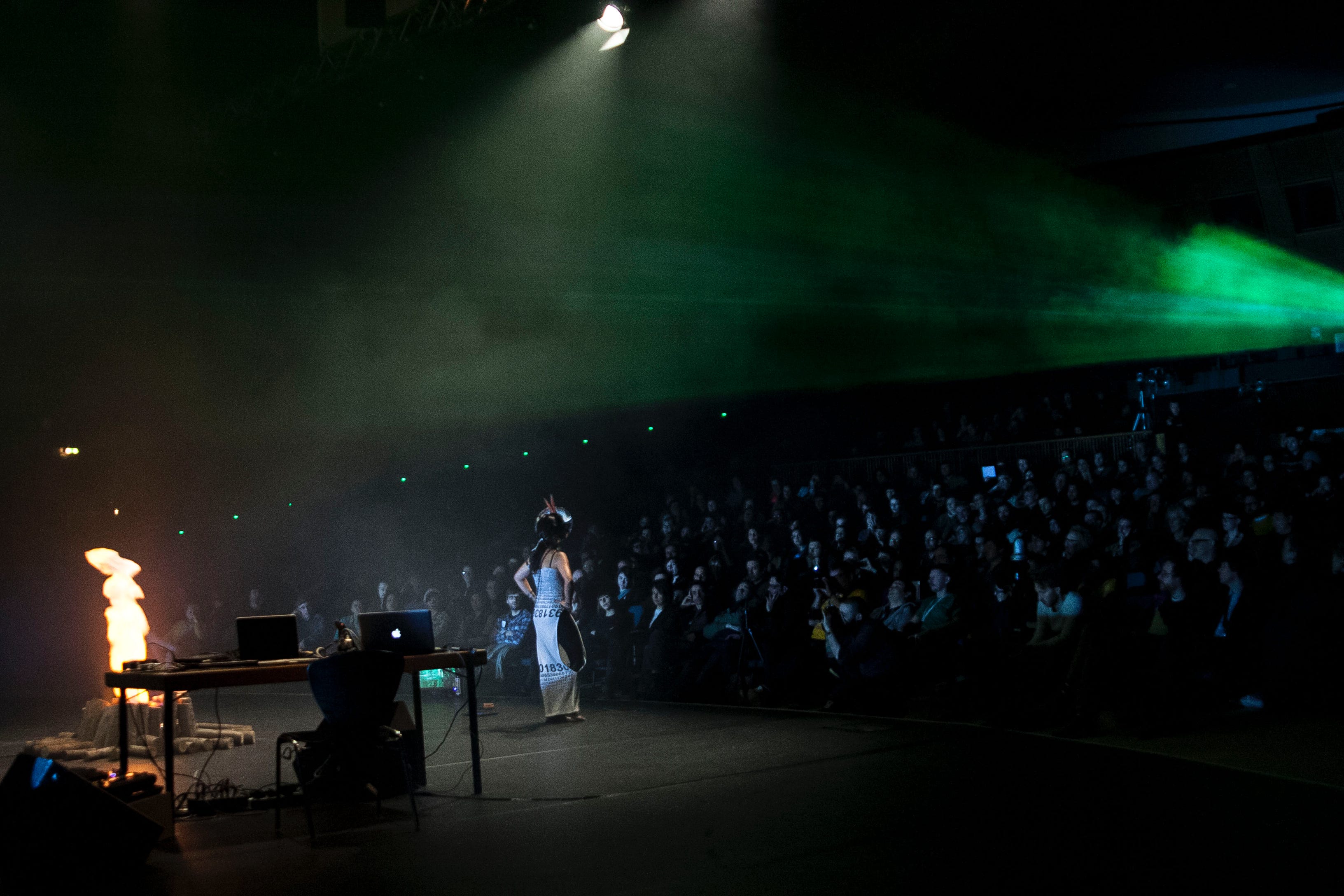
photo: Julia Grachikova
"Freedom is conceivable only as an absurd game with apparatus, as a game with programs." -Vilém Flusser
Berlin, 13.2.2013
Dear reader and Coded Narratives participants at transmediale/CTM.13,
After many great conversations post-performance and numerous emails with questions, here's my reflection that hopefully will contribute to keeping the dialogue open and ongoing. This text although clarifying some aspects of the work and my intentions is not meant to be a full explanation of the performance-installation. Instead I want to propose some thoughts for further thoughts on the experiment. And this is by no means a finished thought, but here's something... for now.
Coded Narratives is in a sense a manifestation of the type of digital culture about which I theorize in Digital Anthropophagy: the so-called user culture, as yet not fully defined, but nevertheless the producer of culture in the internetworked environment. A player in the double-role of the colonizer and the colonized of thought and data production.
In Coded Narratives I wanted to offer a blank space, an empty canvas so to speak, onto which I invite the audience to create its reflection as an interconnected group, by guiding it initially in an attempt to build a narrative. Let's say this is a chance to test intersubjectivity. For the premiere of this performance-installation, there was a very large group of almost 1.000 people in the main auditorium of Haus der Kulturen der Welt, Berlin at the transmediale/CTM festival programs. This large number of attendees although not enabling everyone to participate (only 90 people had a chance to submit a text), naturally mirrored hierarchies online/offline. Not everyone wants to participate and that's absolutely fine. To create more intimacy, I invited people to create a circle around the campfire onstage with me. The audience response was not immediate. It may have been the northern European reaction, even though this was an international festival. But to be fair, we'll only know for sure as the work interacts with other cultures. Notwithstanding, anyone had a chance to come to the stage, and in about 10 minutes the circle was formed with about 15 people. I knew the single tablet would not reach every hand in the auditorium. But anyone sitting far in the back would've also had a chance to come forward upon my invitation. I know this group dynamic is not perfect, but it was an experimental piece. The emerging hierarchy in the venue was similar to our online interactions. People farther away from stage/computer terminal tend to be more like mere spectators in user culture. But to keep a good flow, involving as many people as possible, the “human interface” was presented with a theme to respond to and build a narrative in the one-hour experience. In my introduction onstage, I asked the public to write something related to the theme of demotion, displacement, irrelevance, how they felt/feel in these circumstances and what might come from these "downgrading" situations (transmediale's theme)… or that they could react to the text line before theirs, pose a question to another audience member/user, etc. Some information was also printed in the festivals’ programs and online. But I know that a lot of people don't read about a performance before attending it. And that's fine as well. The text below is a post-performance reflection expressed as an essay.

Testing the Bridge or the Divide between Individuality and Collectivity / Subjects and Objects. Testing Velocity: But Why Involve Morse Code?
Of interest to me as media art researcher is the topic of intersubjectivity (V. Flusser) and the concept of individual and collective individuation through transduction (G. Simondon). In Coded Narratives, we can see the metastable media environment unfolding live in the co-making ad shared hybrid online/offline space.
I use Morse Code as metaphor for speed to slow down the process of communication in order to create a moment of reflection. We cannot appropriately consume information at the current speed rates of digital culture. So, the Morse mediation in the apparatus is used as a step back to reflect on the information in front of us. No matter how vapid some of the text lines were in the feed, they said a lot about the so-called “user culture.” In fact, in the text feed of the performance there were some comments about the lack of speed of the means of communication provided (a tablet). Interesting to note is that I provided a technology that behaves as fast as humans can think-react, type, read and reflect. And upon writing up to two lines and pressing enter, the contributor’s lines could be seen instantaneously onscreen, along with its corresponding morse code binary tone, which the musician (A Guy Called Gerald, UK) used as a sound layer throughout most of the performance as a kind of subconscious tonal reminder of a pre-digital era. I do grant that "users" farther away from the "terminal" could not do much except watch and listen, more akin to a regular theatrical experience. But the audience members sitting closer to the stage who texted in the tablet gave us an outcome nevertheless. So, the question is: Is the user no longer used to sequentiality? Have our brains truly made the crossover to fragmentation to such an extent that it can no longer create or follow narrative? As technology increases, does brain function decrease and intelligence gets reduced to the lowest common denominator, not unlike some of the brain-washing in the days of the lone TV set and its few channels?
Observing the audience’s experience, it seemed either unnerving or beautifully revealing. Either response communicates with the topic of user culture. Some audience members post-performance told me that they simply liked the aesthetics and the reflective underpinnings of the slowed-down proceedings and seeing user culture unfold in front of their eyes. A few left the venue, perhaps not enjoying the slow pace of the proceedings. I welcome this type of feedback, I think a lot can be revealed through boredom. The meditative quality of Coded Narratives is also underscored by a syncretic Indigenous imaginary and rituals of sharing, where the communication space is non-verbal. The techno-shamanic persona in Coded Narratives seeks to transcend the frustration of formalized structures of information processing, and instead wishes for a collective wisdom to materialize in order to break away from the binary isolation. My role was to provide the space, the tools and the aesthetic setup, but what actually happens around the campfire is open. At transmediale/CTM I was determined to undergo the experiment with the invited audience, even if at my own peril as artist facing up to a technical/phenomenological failure of the user.
Human factor as unpredictability into apparatus.
Machines are creating us as much as we have been creating them. Algorithmic systems, which are created by humans, beat back at us with exponential speed. But the problem with algorithms is that it's really not extremely sophisticated. Coding has a lot of limitations, including most of it being articulated in the English language, already by itself creating some limitations and a hierarchy. And we're learning to adapt to those limitations by decreasing ourselves as we're concurrently increasing the potentiality of programming just about everything in life. We can translate abstract thought into projects and objects with the ease of 3D printers for example. But we do it via programming, even if we're not all programmers. And the rapid-fire response from computer calculations is far surpassing our ethical and emotional development. It will be very interesting to see how Digital Natives develop in comparison to the transformations of the Digital Immigrants. For now what we see is that communication development tends toward visual culture and that the break-down of textual language comes from the speed engendered by digital culture, which spurs knee-jerk blurb and slogan language as seen in memes and sometimes spamming. What is this trend really showing us? We must escape the binary prison. The lovely machines we create are indeed liberators when used well. When not, it can enslave us into a dark hole of futility. A masturbatory environment to make any hardcore porn site blush. So what are we to do with ourselves when we are entertained to death in a sort of "alone-together" mode?
Growing up in the analogue word and actively participating in the digital transition, I was prepared for any possible outcome in Coded Narratives. Whereas this initial outcome preoccupies me, I find it absolutely necessary as probatory collective experience. I wanted to hold up a mirror to the audience as culture-makers and and give them a chance to reveal themselves. In this performance-installation premiere in 2.2013, there was something deeper going on in that reflection... We know this audience is made mostly of privileged and well informed people, coming to one of the top international festivals of art, culture and technology. But what occurred is perhaps proof of a brain meltdown, a break of the neurological system stemming from the break of the linear code, a break which philosopher Vilém Flusser foresaw. This goes deeper than McLuhan’s global village, a vision of an interconnected global society. Flusser jumps farther into the "future" in which we are living and well beyond. Flusser sees the ontological transformation of what it means to be human. This is due to the emergence of programmed apparatus, starting with photography, from which he
builds his media philosophy while living in Brazil as a Holocaust refugee. Flusser saw interconnected mediation of networked/user culture experienced via a system that for the first time emulates our neurological function – the next evolutionary step after the Mathematical Revolution.
So, what is the so-called “Digital Revolution” doing to us and what are we doing with it? Perhaps at least from a phenomenological standpoint this is a quiet revolution, with deep-set ontological changes occurring unnoticeably, at least, as of 2013. The irony is that the unpredictable factor (human free-will) in relation to operating the apparatus can produce a predictable result. And this is happening because of programming. User culture produces digital culture artefacts, such as spamming and memes. This tells me that no matter how hard anyone tries to seize an “internetworked” group's attention for building a narrative, a break in the linear code may always be the outcome, the only difference perhaps being the platforms' way of enabling communication, whose speed may vary, and at some point dialogue disintegrates into trivial discourse. Please note my comments only relate to platforms where dialogue is possible or its very aim. And this disintegrative phenomenon by itself would not be so much of a problem, except this behavior transfers to life AFK. And before anyone thinks I am skeptical toward technology, I'll just say that my laptop is more natural to me than my house plants and I feel all the poorer for acknowledging this. But I simply cannot imagine my life without computer technology, as much as I cannot live without air or water. At 2013 I remain optimistic and I do think that any sustainable technology combined with quality communication (speed+empathy+ethics) can point us in the right direction, whereas toward a liveable planet (caring for nature, mindful of ecology)… or toward an emergency exit to the Moon. But who will be able to afford it?
Private x Public Dynamics in a group environment: Is there a community?
Testing Empathy
My interest in phenomenology of digital culture, media philosophy, cybernetics stems vastly from seeing that faster communication technologies and an enormous array of choices have not necessarily contributed to the quality of communication. And in this process I look into interpersonal relationships and intersubjectivity. The quantity of communication has certainly exponentially increased in the digital era, but humans still struggle establishing quality in communication. As shown in the text feed during the performance (see below), many, if not most participants wound up projecting themselves as single planets circling in their own orbit without much interaction with others. Most comments were self-centered blurbs without creating reactive commentary or showing empathy to one another. So the question of velocity of the apparatus became inevitable. Has boredom set in because the interface is not fast enough? But along with it, the question arises of who is the apparatus-interface? Has the user become that? Would a faster interface or multiple interfaces change the outcome? I know this sounds frustrating and I accept responsibility if the audience did not completely understand my intention of creating a narrative around a specific theme. But let's think of a current-day IRC chat room: the synchronous conferencing does not necessarily build sequential thinking or empathy. Too many thoughts are lost in the velocity of the scroll. The collective conversation ends up quite often in random individuality. A moderator sometimes helps but can also become a bias. And the faster the exchange, the lower the quality of the communication. The essence of the quality in the communication is the emotional response and the ability to create sequential thought. Otherwise, we are no better than machines. The core of the issue is that as technology evolves toward inhuman speed, our phenomenology will also continue to change, and this change is inevitable. We must accept that we have already changed, and there's no going back. Evolution does not stop for nostalgia. We must appreciate the past but carry on making the best use of current technologies and make twice the effort against being programmed to death. If we accept the prison of becoming functionaries of the machine, a possibility that Vilém Flusser warned against, we'll lose the possibility of freeing the Homo Ludens. In this context, art is of highest importance to create spaces for this Homo Ludens to break away from all this constant programming. But there's also something else that will help us break away...
Where has the freedom gone?
Dear reader, don't let this become a perverted game where the machine sucks our collective soul and they become us as we become them. But I do accept that at some point we meet in the middle. No one will notice when we are all hybrids. Will anyone care? Probably not, especially if machines will absorb our empathy. Whereas we'll have a real owl on a tree or a chip-owl next to our pillow, life will go on as (un)usual.
As for me, I think I have an answer to the labyrinth of the abundance of technology and the uncontrollable desire to upgrade and go faster, faster, faster…
LOVE! Yes, love will save us. Please, dear reader, break away from the binary limitations. Sharing means caring, share yourselves and love one another. Get out there and have fun, Homo Ludens, with each other, as much as with your machines of loving grace.
And dear participating audience, I love you! May we find our way out of the matrix. Or at the very least, when we can no longer find satisfaction in our wonderful machines, that we are not afraid to die trying.
p.s. I also love transmediale and CTM for taking a chance and embarking on this adventurous experiment with A Guy Called Gerald and I.
Vanessa Ramos-Velasquez
February 2013.

Coded Narratives
Text file of live text feed during performance proceedings. 2.1.2013 transmediale/CTM
HELLO WORLD!
What would you do if you were demoted to a position of lower relevance?
>ENTER
1, ....;
2, ...;
3, .....;
4, "hello world";
5, "hello world!";
(actual start of narrative)
6, "i dont count on a secure position. i never had one.";
7, "if i\"m taken down. i get up and move on, come with me!";
8, "move with the freedom of the fire, let water lead the way.";
9, "no time. no space. no place. just people.";
10, "feel the beat.beat.beat";
11, "always pull up the bass";
12, "time has come to stay at pluto,at acid pluto.";
13, "hey a guy can you call the audience";
14, "the fire is a flying textiletexture";
15, "okso well really it is athimgthat causes fire i am a physical thimg like fire i am going";
16, "guys. it smells really good here.";
17, "the one who has the key to enter earth, pls, show us.";
18, "destruction of european culture... emergent cities worldwide";
19, "and on exquisite. the corpse. the wood is real, fire walks with me";
20, "i will walk rherough the fire. where eslse will turn? let it burn...";
21, heartbeatplutoputoblood.;
22, "...reporting from earth. opinions so far are not very clear...";
23, "they seem to like fire and water...";
24, "i\"m still curious about the downgrading thing";
25, "i want to be the girl, who warms your mothers heart";
26, "pass me the beer my friend.";
27, "you have just won 150.000 in the european lottery";
28, "viagra without a prescription";
29, "lets burn another one down";
30, "being userless";
31, "please, save me";
32, "just wondering what";
33, "when did u was writing the letter last time? i meen sending it by post, not an email....";
34, "downgradimg myself by anticipation of what others might think. and my heart goes boom boom boom";
35, "if i was a fish, i would never know the world above the surface";
36, "damn, this digital dutchie is realy getting me high";
37, "where am i?..";
38, "i wear my beard oon the inside an the only way you will ever see it is if you cut me open witha cleaver made of love...";
39, "downgrading is all in the mind. think of it as a free upgrade and ou will feel much beteer. anyway pluto doesnt care.";
40, quadrophony?...;
41, "sorry pluto mi english kuld changeyour cours";
42, "please downgrade me umtil i\"m back where i started.";
43, "we just proved that community is not a collection of individuals...";
44, "what does morse happiness sound like? :)";
45, "pluto the forbidddn planet and how she doth laugh";
46, "it feels like watching an arthouse remake of cloud atlas. seriously what is going on?";
47, "never forget to look at the world with your own eyes";
48, "it seems good art really needs a superuser.";
49, "my heart is bleeding as i have lost a spiritual father. may my tears become a river that leas him to the next dimension";
50, "sry butthisboring me";
51, "hab ich das richtig verstanden";
52, "stay free and you will be skipped out of the system.";
53, "irc might have been a faster input sydtem...";
54, "boom. boom. bom. bombom. bumbum.";
55, "now i know what it feels like to sit in the middle of a facebook newsfeed..";
56, "when the shark stops moving it will sink to the ground and die";
57, "&k&sdruhks&tftktfsuhg&krdshuh k&xudrghgkxduhrlk&xudrhg k&xdrhg&kjshd kj&fxrh&kjsndgr dsrk&jhxfgk&jnh";
58, "i am im in the dark. let me show you the way.";
59, "dot dot dot dash dash dash dot dot dot";
60, "kann jemand esperanto?";
61, "and on the stagethey r drinking,liquid in the bottle is getting less";
62, "my friemd jonathan romley watvhes his dog mastabbate";
63, "delete yourself you have no chance to win";
64, "anasthatics intead of aesthetics?";
65, "i wonder how long will it take for the orgasm...";
66, "i am pluto, goofie.s dog, i am lproserpina,in,orbit half the year";
67, "did u no morse speld bakwrds is esrom";
68, "this ipad will explode in 5 mim and burn your face, go ahead, insteaf mdma for free in the toilet, it might help with the boredom";
69, whazthesecretofthemeaningless;
70, "shamanista, prevai!!!";
71, "more input equals more music - give this guy sth to play around!!!!!";
72, "toger but alone";
73, "my eyes are cds and my mind is the player :)";
74, "love is a well aimed sledgehammer in someones smiling face";
75, "lets downgrade to acid techno";
76, "is there any good doctor in the hall?";
77, putmorselayerloudersssssssssssssssssssssssssssssssssooooooooooooooooooooooooooooooooooooooooooooooooooooooooooooooooooooooooooooooo;
78, moremusicmoremusic;
79, q:);
80, "eat up it will do you good!!!!";
81, "searching 10010010010010000100101000100101 complete";
82, applaus;
83, "turn around, every now and then ...";
84, "hey i was thinking the same";
85, .;
86, ". .";
87, ". .";
88, ". .";
89, ............................;
90, \,\,\,\,\,\,\,\,\,\,\,\,\,\,\,\,\,\,\,;
91, )))))))))))))))));
92, ?????????????????;
93, 11111111111111111111111111111111111111111111111;
94, lol;



